
The terciopelo is a species of pit vipers, found from north-east Mexico to northern South America. At low to moderate elevations, its habitat ranges from northeastern Mexico to Colombian and Ecuadorian Andes, as well as Venezuela. With a mass of up to 6 kilograms (13 lb), and a maximal length of 2.5 metres (8.2 ft), the terciopelo is among the largest vipers. It is light to dark brown in color, often with yellowish, zig-zag patterning on either side of its body. Dubbed "the ultimate pit-viper" for its defensiveness, large size, fangs and potent venom yield, it has a fearsome reputation, responsible for the most envenomated snakebites within its range, largely due to its proximity to humans, livestock and pets. Nonetheless, like all venomous snakes, the terciopelo actively avoids contact with humans and larger animals, with bites generally only occurring when the snake is cornered, pursued, or threatened. No subspecies are currently recognized.

Bothriechis is a genus of pit vipers, commonly called palm vipers or palm-pit vipers found predominantly in Mexico and Central America, although the most common species, B. schlegelii, ranges as far south as Colombia and Peru. All members are relatively slender and arboreal. The name Bothriechis is derived from the Greek words bothros and echis that mean "pit" and "viper" respectively. Ten species and no subspecies are currently generally recognized.

Cerrophidion is a genus of pit vipers which are endemic to southern Mexico, Central America, and western Panama. The generic name, Cerrophidion, is derived from the Spanish word cerro, which means "mountain", and the Greek word ophidion, which means "small snake". Five species are recognized as being valid, but no subspecies are.

Porthidium is a genus of pit vipers found in Mexico and southward to northern South America. The name is derived from the Greek word portheo and the suffix -idus, which mean "destroy" and "having the nature of", apparently a reference to the venom. As of August 2016 nine species are recognized as being valid. The snakes of the genus Hypnale in southern India and Sri Lanka look quite similar to those of this genus, possibly an example of convergent evolution.

Bothrops ammodytoides is a pit viper species endemic to Argentina. No subspecies are currently recognized.
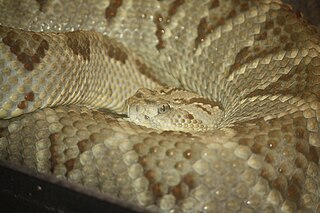
Crotalus simus is a venomous pit viper species found in Mexico and Central America. The specific epithet is Latin for "flat-nosed", likely because its head is blunt compared with lanceheads (Bothrops). Three subspecies are recognized, including the nominate subspecies described here.
Crotalus totonacus is a venomous pit viper species found in northeastern Mexico. No subspecies are currently recognized.
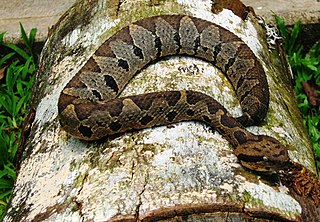
Metlapilcoatlus olmec is a pit viper species found in Mexico. No subspecies are currently recognized.
Atropoides picadoi, also known as Picado's jumping pit viper, is a pit viper species in the subfamily Crotalinae of the family Viperidae. The species is endemic to Costa Rica. There are no subspecies that are recognised as being valid. It is monotypic in the genus Atropoides.

Porthidium dunni is a species of pit viper in the family Viperidae. The species is endemic to Mexico. There are no recognized subspecies.

Porthidium hespere is a pit viper species found in western Mexico. No subspecies are currently recognized.
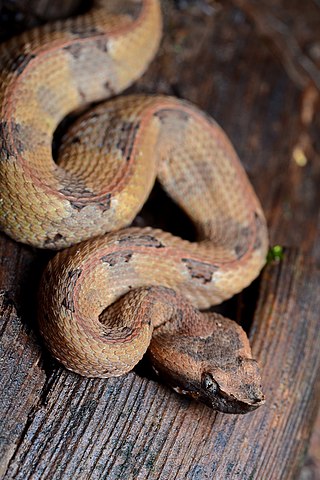
Porthidium nasutum is a pit viper species found in southern Mexico, Central America and northern South America. No subspecies are currently recognized.
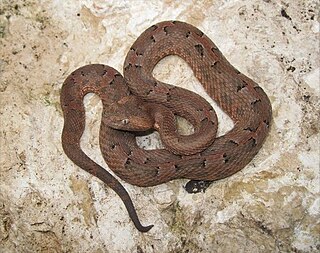
Porthidium yucatanicum is a pit viper species found in Mexico. No subspecies are currently recognized.

Bothrops taeniatus, the speckled forest-pitviper, is a species of pit viper found in the equatorial forests of South America endemic to Colombia, Ecuador, Peru, And Brazil. The specific name, taenia, is derived from the Greek word, tainia, meaning ribbon bandage or stripe, in reference to the slender body. Two subspecies are currently recognized, including the nominate subspecies described here.

Bothrops bilineatus, also known as the two-striped forest-pitviper, parrotsnake, Amazonian palm viper, or green jararaca, is a highly venomous pit viper species found in the Amazon region of South America. Two subspecies are currently recognized, including the nominate subspecies described here. A pale green arboreal species that may reach 1 m (3.3 ft) in length, it is an important cause of snakebite throughout the entire Amazon region.

Metlapilcoatlus mexicanus is a pit viper species endemic to Mexico and Central America.

Lachesis melanocephala is a species of pit viper in the family Viperidae. The species is native to Costa Rica and Panama. There are no subspecies that are recognized as being valid.
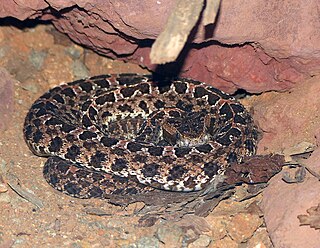
Porthidium ophryomegas is a venomous pitviper species found in Central America. No subspecies are currently recognized.

Porthidium volcanicum, the Ujarran hognosed pit viper, is a pit viper species endemic to Costa Rica. No subspecies are currently recognized.

Bothrocophias campbelli, commonly known as Campbell's toadheaded viper, the Ecuadorian toadheaded pitviper, and víbora boca de sapo in Spanish, is a species of venomous pitviper in the family Viperidae. The species is endemic to South America. No subspecies are currently recognized.



















